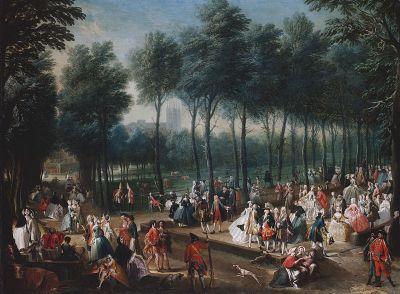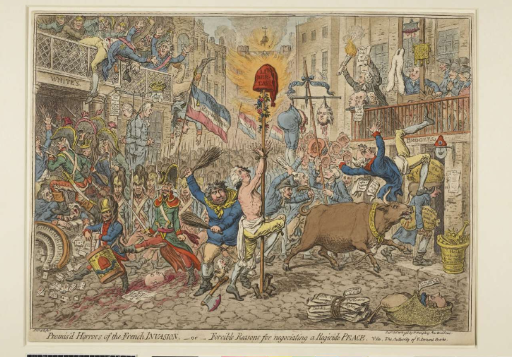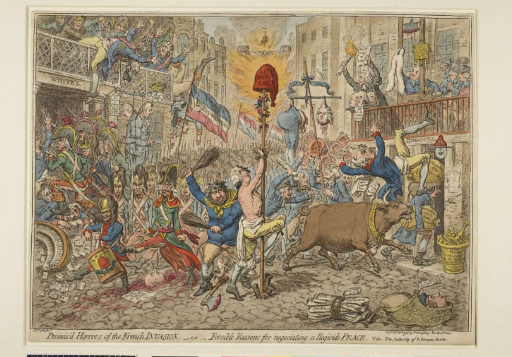Abstract
St James’s refers to an urban area located in what we know as the West End of London, more precisely in the district of Westminster. To account for its full spatial as well as social dimensions and to understand what role it played in the emergence and fashioning of London sociability, it is essential to consider St James’s as intrinsically associated with its main architectural elements: St James’s Palace, St James’s Park, St James’s Square, St James’s Street and its coffeehouses and clubs.
Keywords
The political revolution that established William and Mary on the throne in 1689 had new constitutional terms which meant yearly meetings of Parliament. This brought the titled to London between November and June, and created the ‘London season‘, a concept at the heart of London urban sociability. The renaissance of Court life in St James’s ‘shifted London’s population northwards and westwards, and smart developments appeared in St James’s’.1 St James’s was the site where the ‘seasonal elite’ concentrated in a very small area. The need to house the Lords’ families and retinue, and to support their domestic and entertainment consumption as well as service necessities, created the conditions for the development and flourishing of the area. The list of elite people, as well as ‘artisans’ and service and goods, who occupied houses or apartments there is testimony to the centrality of St James’s to social networks and alliances.
- 1. Andrew Saint and Gillian Darley, The Chronicles of London (London: Weidenfeld and Nicolson, 1994), p. 110.
St James’s Palace
Charles II, who disliked Whitehall Palace, made St James’s his principal residence, improving the grounds, laying them out ‘with a long straight canal down the centre, and then opened the park to the public, so that he might see and be seen by his subjects‘.2
When Whitehall was accidentally destroyed by fire in 1698, William III asked Sir Christopher Wren to create new state rooms at St James’s. The Court became ‘a constellation of smaller residences’, splitting ‘ceremony and residence’ over several sites. This fragmentation not only changed ‘the practice of monarchy and court culture’ but solidified it (Greig 104, 107, 129). The Court developed into a site for both formal and informal sociability, St James’s Palace being the site for drawing rooms and balls. George I hosted twice-weekly meetings at St James’s, noted for the spectacular attire of the nobility who attended there (Greig 106, 107, 109, 113, 124). The presence of the palace gave its immediate surroundings ‘something of an aristocratic air’.3
St James’s Park
St James’s Park had originally been drained and enclosed by Henry VIII as royal hunting ground. Following the Restoration, Charles II ‘poured large sums of money into fashioning St James’s Park as a reinstatement of natural order.’ It became one of London’s most fashionable promenades, especially for women.4 Throughout the eighteenth century, visitors, especially foreign ones, were impressed by the park’s beauty and size, and commented on its popularity as a sociable public space. One visitor remarked that it was the place ‘where Court and the Beau Monde meet‘,5 and another that on Sunday afternoons, about ‘one thousand souls’ could be seen in this public promenade (La Combe 85-86).
- 2. Ann Saunders, The Art and Architecture of London: An Illustrated Guide (London: Phaidon Press, [1984]; 2nd ed., 1988), p. 139.
- 3. E. Beresford Chancellor, The West End of Yesterday and Today: Being Studies in London's History and Topography During the Past Century (London: Architectural, 1926), p. 167.
- 4. M. La Combe, Tableau de Londres et de ses environs (Londres: société typographique, 1784), p. 85-86; Laura Williams, ‘‘To recreate and refresh their dulled spirits in the sweet and Wholesome ayre’: green space and the growth of the city‘, in J. F. Merritt (ed.), Imagining Early Modern London: Perceptions of the City from Stowe to Strype 1598-1720 (Cambridge: Cambridge University Press, 2001, p. 185-213), p. 189-90.
- 5. Pierre-Jean Grosley, Londres, 3 vols. (Neuchâtel, 1774), vol. 1, p. 114.
St James’s Square
London squares were ‘the joint creation of the great and usually aristocratic landlord and the speculative builder‘.6 Charles II granted the freehold of the site of St James's Square and other adjacent property to trustees for the Earl of St Albans on 1 April 1665. The square itself took shape in the 1670s.7 St Albans developed 22 plots and ‘let them or sold them partly to his noble friends and partly to professional speculators who proceeded to build houses for letting’.8
By 1720, the square was described as ‘a large handsome Place, encompassed with Rails, and graced on all Sides with large Buildings, inhabited chiefly by the Nobility’.9 Robert Adam built several houses on the square.10 His houses, ‘devised for the conduct of an elaborate social parade,’ were made for sociability (Summerson 149). The square was frequented by the Beau Monde and became ‘one of the most prestigious town addresses.’ This ‘ensured that high-ranking peers, key political figures, aspiring politicians, their extended families, acquaintances, and intermediaries, were likely to be encountered in a range of predictable places and contexts’ (Greig 165). St James’s Square provided a frame for a sociable culture deployed in numerous visits − often made by women − as well as balls and assemblies (Greig 139). Horace Walpole, who attended the reception at the opening of the state apartments at Norfolk House, commented:
‘All the earth was there last Tuesday. You would have thought there had been a comet, everyone was gaping in the air and treading on one another’s toes […] you never saw such a scene of magnificence and taste. The tapestry, the embroidered bed, the illumination, the glasses, the lightness and novelty of the ornaments, and the ceilings, are delightful.‘11
- 6. George Rudé, Hanoverian London 1714-1808 (London: Secker and Warburg, 1971), p. 12.
- 7. ‘St. James’s Square: General‘, Survey of London: Volumes 29 and 30, St James Westminster, Part 1, ed. F H W Sheppard (London, 1960, p. 56-76). British History Online (http://www.british-history.ac.uk/survey-london/ vols29-30/pt1/pp56-76 [accessed 1 June 2019]).
- 8. John Summerson, Georgian London (New Haven and London: Yale University Press, [1945], 2003), p. 25-27.
- 9. John Strype, The Survey of London, 2 vols. (London, 1720, Book 6, Chapter 6).
- 10. The façade of No. 20 was designed by Robert Adam for Sir Watkin Williams-Wynn from 1771–1775 (Saunders, p. 142).
- 11. Autobiography and Correspondence of Mary Granville, Mrs. Delany, ed. Lady Llanover, 1st series (London: Richard Bentley, 1861), vol. 3, p. 409; The Letters of Horace Walpole, ed. Mrs Paget Toynbee, 16 vols. (Oxford: Clarendon Press, 1903), vol. 3, February 12, 1756, p. 396.
St James’s Street
As one of the main streets of St James’s, St James’s Street runs from Piccadilly down to Pall Mall. The building of smaller houses and the commercial expansion of St James’s street favoured the development of ‘services and tradesmen‘ that provided for the needs of elegant residents of the square and tributary streets. This could be seen in the variety of trades that crowded together on the east side of the street – hat maker, carriage builder, engraver, tailor, grocer, silversmith, jeweller, gun and pistol manufactory, perfumer, saddler, bootmaker, clockmaker, etc. The west side had fewer shops but was still adorned by a Magasin de Nouveautés, a French Bread and Biscuit Baker, and a sword cutler (Chancellor 51). At the South end of St James’s Street, Pall Mall was also one of the first important shopping streets of the area, with a profusion of new luxury shops. St James’s Street was crowded with the carriages of the ladies and gentlemen walking in the Mall, ‘the ladies with their heads in full dress and the gentlemen carrying their hats under their arms,’ noted a contemporary.12
- 12. Recollections of the Table-Talk of Samuel Rogers (London: Edward Moxon, 1856), p. 10-11.
St James’s Street featured many coffeehouses and chocolate-houses, which were the places of rendez-vous of people of fashion, and where one could meet, read the news, indulge in conversation and drink those new exotic beverages, coffee or chocolate. Continental travellers described an almost ritualized performance of sociability: ‘At 12 o’clock, the Beau Monde assembles in several coffee and chocolate-houses […] all these are so near to one another that in less than an hour, you can see the company of them all’.13
- 13. John Macky, Journey through England [1714] (2nd ed., London: J. Hooke, 1722), p. 168.
First located on the east side of St James’s Street, White’s was opened as a chocolate house in 1693 by Francis White. Four years later, it moved to the street’s west side, at No 69. By then, it was reputed for its high gambling.14 The house and its adjoining buildings were completely destroyed by fire in April 1733,15 as depicted in ‘Scene in a Gaming House‘ (1735) in Hogarth’s A Rake’s Progress. White’s became a private club in 1736 and moved to its own clubhouse in 1755, called ‘the great house’ at No 37 on the east side of the street (its present location). Its famous bow window allowed its members both to see and to be seen, displaying the club’s social exclusivity. A vivid description in the London Journal (1727) pictured White’s as the temple of fashion and elite sociability: ‘At White’s we see nothing but what wears the Mask of Gaiety and Pleasure. Powder and Embroidery are the Ornaments of the Place, not to forget that intolerable Stink of Perfumes which almost poysons the miserable Chair-men that besiege the Door’.16
At No 85 on the east side of the street stood the famous Thatched House Tavern, which welcomed, at different periods of its history, the meetings of the Brothers’ Club (created in 1711), the Society of Dilettanti (founded in 1734) and Johnson’s Club (created in 1764). Other gentlemen’s clubs were located in St James’s street, such as Boodle’s (founded by the Earl of Shelburne in 1762) which moved to its present location on the East side at No 28 in 1782 in a new building designed in 1775 by John Crunden. On the West side of the street, Brooks’s (founded in 1764) was established in 1777 at No 60 in a clubhouse designed by Henry Holland.17 The fact that White’s and Brooks’s were almost geographically facing each other in St James’s Street symbolically reinforced the two institutions’ rivalry as illustrated by James Gillray’s caricature, ‘Promis’d Horrors of the French Invasion‘ (1796).
The concentration of so many coffeehouses and clubs in what was a rather spatially restricted perimeter explains the social vitality of the area and its identification with elite sociability.
- 14. ‘Had I all counties, I to White’s would go / And set lands, woods, and rivers, at a throw’. James Bramston, Man of Trade (London: Lawton Gilliver, 1733), p. 15.
- 15. ‘This is to acquaint all noblemen and gentlemen that Mr Arthur having had the misfortune to be burnt out of White’s Chocolate-House is removed to Gaunt’s Coffee-House, next to the St. James’s Coffee-House in St. James’s Street, where he humbly begs they will favour him with their company as usual’ (Daily Post, May 3rd, 1733).
- 16. Quoted in E. J. Burford, Royal St James’s, being a Story of Kings, Clubmen and Courtesans (London: Yale University Press, 1998), p. 135.
- 17. Charles James Fox, Brooks’s most famous member, became strongly identified with the club and its gambling activity.
For most of the eighteenth century, St James’s stood as a powerful blend of political power, architectural innovation, luxurious consumption, and fashionable and commercial pursuits, making it an extraordinarily vibrant centre of sociability. As George A. Selwyn would put it, ‘a small society governed England and gambled in St James’s Street’.18
- 18. George Selwyn, his Letters and his Life, ed. E. S. Roscoe and Helen Clergue, London: T. Fisher Unwin, 1899, p. 19.
Share
Further Reading
Beresford Chancellor, E., Memorials of St James’s Street (London: Grant Richards, 1922).
Greig, Hannah, The Beau Monde: Fashionable Society in Georgian London (Oxford: Oxford University Press, 2013).
McWilliam, Rohan, London's West End: Creating the Pleasure District, 1800-1914 (Oxford: Oxford University Press, 2020).
Muralt, Béat-Louis (de), Letters Describing the Character and Customs of the English and French Nations (London: T. Edlin, 1726).
Rendell, Jane, ‘The Clubs of St. James’s Street: Exclusivity, Domesticity and Secrecy ‘, Journal of Architecture (vol. 4, n° 2, 1999), p. 167-189.
Stow, John, Survey of London, ed. John Strype, 2 vols. (London: A. Churchill, 1720) (https://www.dhi.ac.uk/strype/ [accessed 19 March 2021]).
Summerson, John, Georgian London [1945] (New Haven and London: Yale University Press, 2003).


